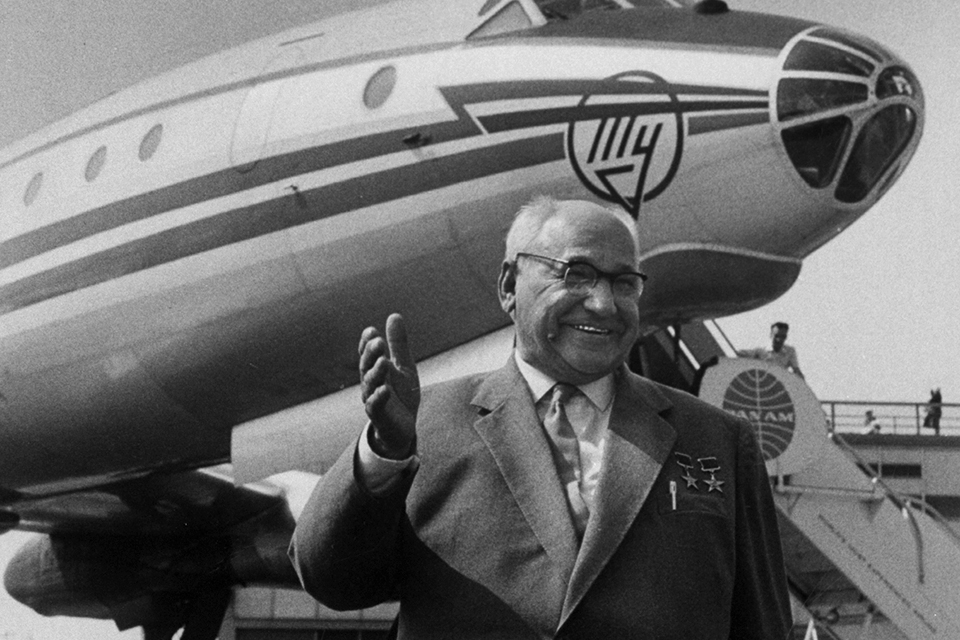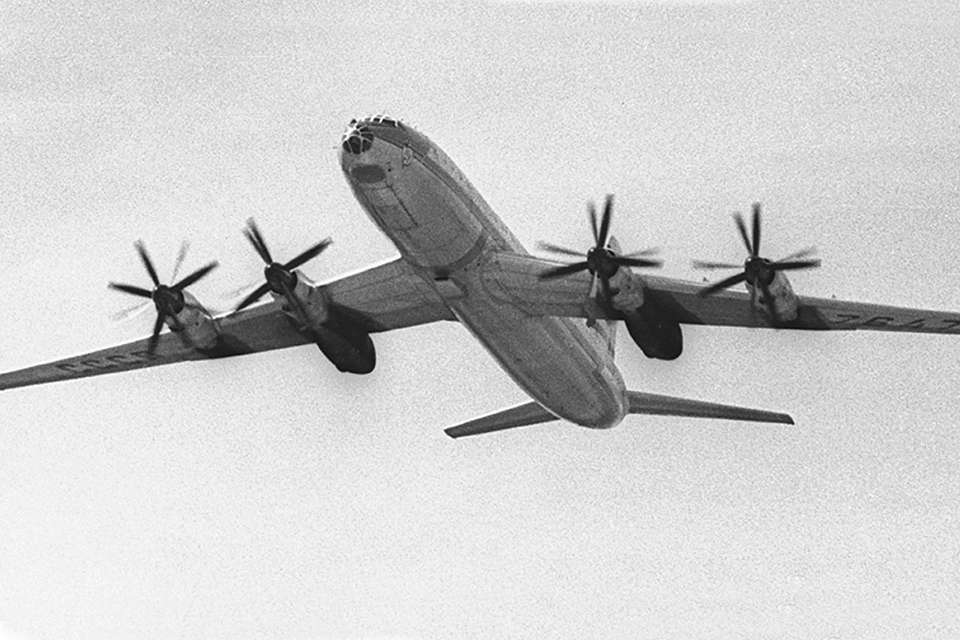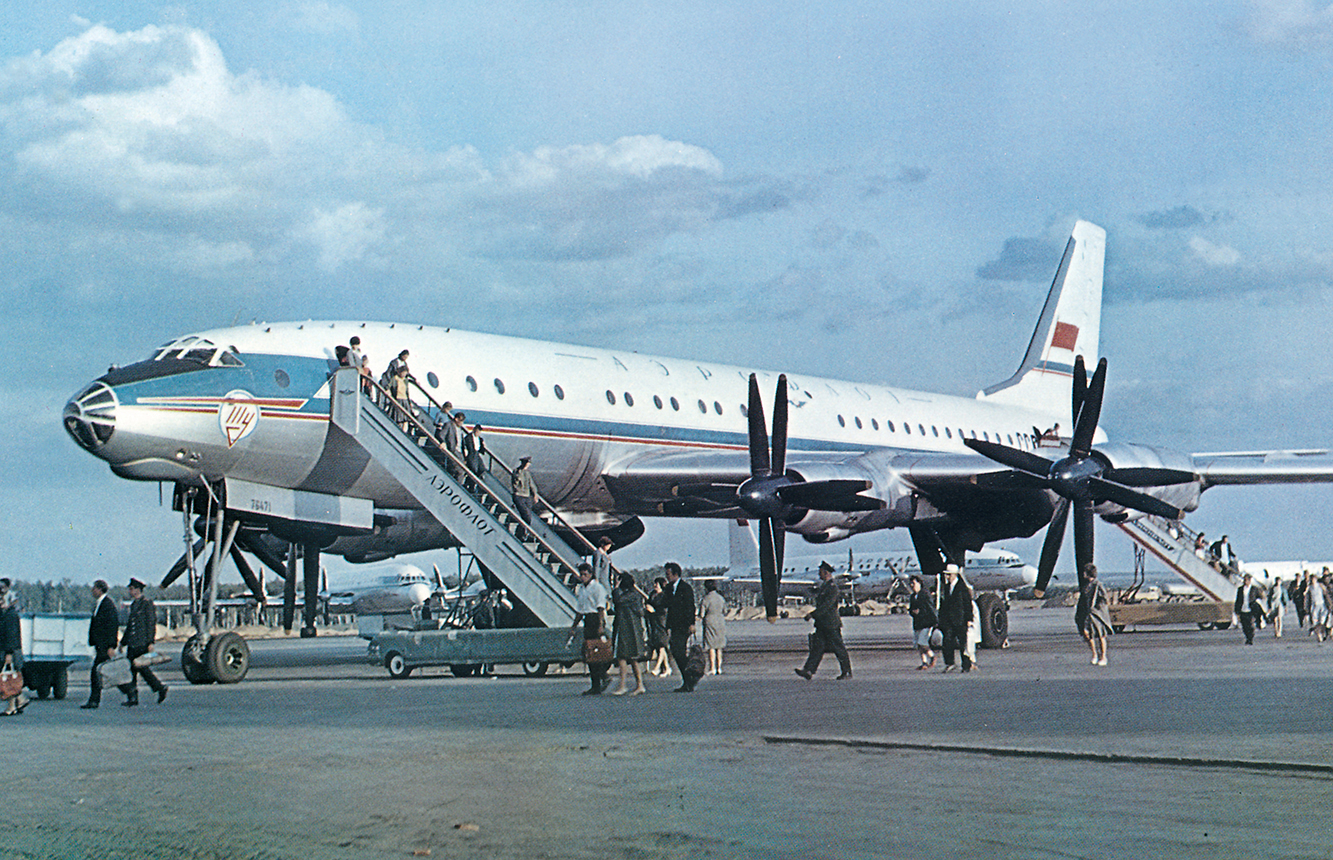The peculiar passion that Russians seem to harbor for huge aircraft can be traced all the way back to 1913, when Igor Sikorsky built the Russky Vityaz, the world’s first four-engine airplane and the largest in the world at that time. Their enthusiasm for giants continued into World War I, with the production of Sikorsky’s four-engine Ilya Muromets, and persisted throughout the Soviet era. While many Soviet designers created gargantuan airplanes, the most consistently successful ones originated from the design bureau headed by Andrei Tupolev.
For more than 60 years, Tupolev remained one of the most influential Russian aircraft designers in spite of being twice arrested for subversive activities—once by the Tsarist regime and once by the Soviets. In fact, Tupolev actually developed his highly successful Tu-2 medium bomber while imprisoned for treason by Josef Stalin during World War II.

After Stalin’s death in 1953, a relative thaw began in Soviet-Western relations. Unlike Stalin, Premier Nikita Khrushchev was willing to travel abroad in order to confer with his Western counterparts. He also sought to publicize Soviet technological achievements to the rest of the world. The accomplishment of those objectives, however, would require the development of a suitably prestigious transport aircraft, which at that time did not exist in the Soviet Union. That deficiency was emphasized during Khrushchev’s arrival at the 1955 summit in Geneva in an Ilyushin Il-14. While a perfectly adequate twin-engine airliner, the Il-14 was overshadowed by President Dwight D. Eisenhower’s sleek four-engine Lockheed Super Constellation Columbine III.
The Soviet Air Ministry turned to Tupolev, issuing a specification for a large, fast transport with a range of 8,000 kilometers (4,971 miles). Tupolev had already developed a successful jet-powered airliner, the Tu-104, but it was designed to fly only moderate distances and was not suitable for transoceanic flights. Tupolev’s solution was to develop an airliner—the Tu-114—from his Tu-95 “Bear,” the first Soviet strategic nuclear bomber with true intercontinental range.
It was not a particularly original idea. Boeing had already developed its 307 Stratoliner and 377 Stratocruiser airliners from its B-17 and B-29 bombers, respectively, while Avro developed its Lancastrian and Tudor airliners from its Lancaster bomber.
The TU-114’s Entirely New Design
The Tu-114 featured an entirely new fuselage with a pressurized cabin that could accommodate up to 224 passengers. The 35-degree swept wing was relocated from the high-wing position used on the Tu-95 to a low-wing position on the airliner. An entirely new tail and stabilizer were also designed. Power was provided by four Kuznetsov NK-12MV turboprop engines driving contrarotating propellers, each delivering 14,795 hp. The resulting aircraft had a wingspan of 168 feet, a length of 178 feet and a takeoff weight of 385,809 pounds. Its maximum speed was 541 mph and it cruised at 478 mph, with a maximum range of 5,244 miles.
Concurrent with the Tu-114, Tupolev also developed another passenger-carrying version of the Tu-95, the Tu-116. Its official purpose was “to conduct route and scheduling studies, propulsion system tests and study compatibility issues with civil airports.” In reality, however, it was intended to serve as a hedge against the possible failure or protracted development of the Tu-114. The Tu-116 involved a far less extensive redesign of the Tu-95, utilizing the bomber’s existing fuselage with the addition of relatively small pressurized passenger cabins fore and aft of the wings, the latter accessed via a folding ladder beneath the tail. But within a few months of the Tu-114’s successful first flight on October 3, 1957, it became apparent that the Tu-116 would be unnecessary, so only two examples were ever completed.
ON Display
The Tu-114 was displayed at the Brussels World Exhibition in 1958. Then, despite the misgivings of many aeronautical engineers about the employment of a still-experimental aircraft for such a purpose, Khrushchev insisted upon flying in it for his September 1959 visit to the United States. Since worrisome hairline cracks had appeared in the engine nacelles, special engineers accompanied Khrushchev’s party and every Soviet warship in or near its flight path stood at full alert in case anything went wrong. Fortunately for all concerned, the aircraft performed satisfactorily throughout the long excursion.

The Tu-114 certainly created a splash in the U.S. It was the largest airliner in the world at the time, and though not quite as fast as the new Boeing 707 and Douglas DC-8 jetliners, was very nearly as fast, while being able to carry a significantly larger payload over a considerably longer distance. In fact, the Tu-114 set several speed, altitude and payload records for turboprop-powered aircraft that still stand to this day. It has held the Fédération Aéronautique Internationale’s world speed record for propeller aircraft in a closed circuit since 1960.
Commercial use
Having so dramatically proven itself, the Tu-114 entered commercial service in April 1961, with a total of 32 eventually built. It remained the flagship of the Soviet airline Aeroflot until 1971, when it began to be superseded by the Ilyushin Il-62, a large airliner with four jet engines mounted beneath its tail, bearing a suspicious resemblance to Britain’s Vickers VC-10. Although displaced from international routes, Tu-114s continued in domestic commercial service until 1976, leaving behind an enviable safety record. Only one was ever involved in a fatal accident, and that occurred when the pilot tried to take off from a runway that had not been properly cleared of snow. Its principal fault lay in the engines—the most powerful turboprops were also among the noisiest.
After their commercial career ended, about a dozen Tu-114s were modified into airborne early-warning platforms. Redesignated Tu-126s, the AWACS versions of the Tu-114 remained in service until 1990, and one is known to have been transferred to the Indian Air Force.
This feature originally appeared in the September 2019 issue of Aviation History.
historynet magazines
Our 9 best-selling history titles feature in-depth storytelling and iconic imagery to engage and inform on the people, the wars, and the events that shaped America and the world.







